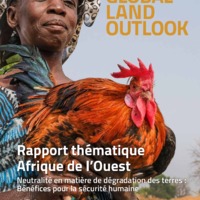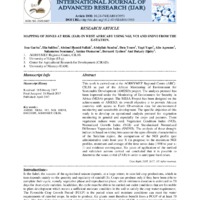Recherche
2 items
Global Land Outlook : Rapport thématique Afrique de l’Ouest. Neutralité en matière de dégradation des terres : Bénéfices pour la sécurité humaine
Le présent rapport thématique du GLO sur l’Afrique de l’Ouest et le Sahel a été élaboré par le Centre régional AGRHYMET dans le cadre d’un Mémorandum d’accord signé en 2019 entre le Comité permanent inter-États de lutte contre la sécheresse dans le Sahel (CILSS) et la Convention des Nations Unies sur la lutte contre la désertification (CNULCD). Ce travail a été accompli avec l’appui généreux de TetraTech, USAID et SERVIR Afrique de l’Ouest. Analysant les enjeux, contraintes et atouts de 7 pays sahéliens (Burkina Faso, Mali, Mauritanie, Niger, Nigéria, Sénégal et Tchad), ce rapport thématique régional met en lumière les acquis et opportunités existants pour favoriser le développement durable et inclusif de toute la région. Ainsi, faisant face à la dégradation des terres, de bonnes pratiques de Gestion Durable des Terres (GDT) ont été développées.
Mapping of zones at risk in west Africa by using NGI, VCI and SNDVI from the E-Station.
This work is carried out at the AGRHYMET Regional Centre (ARC)-CILSS as part of the African Monitoring of Environment for Sustainable Development (AMESD) project. The analysis protocol has been improved under the Monitoring of Environment for Security in Africa (MESA) project. The MESA Project has been designed on the achievements of AMESD; its overall objective is to provide African countries with access to Earth Observation data for environmental monitoring and sustainable development. The specific objective of this study is to develop an operational analysis protocol for vegetation monitoring in general and especially for crops and pastures. Three vegetation indices were used: Vegetation Condition Index (VCI), Normalized Growth Index (NGI) and Standardized Normalized Difference Vegetation Index (SNDVI). The analysis of these drought indices is based on taking into account the agro-climatic characteristics of the Sahelian region, the comparison of the NGI profile (per administrative unit) from year X (in progress) to the maximum NGI profiles, minimum and average of the time series data (1998 to year x-1) and evidence convergence. Six years of application of the method and validation actions carried out concluded that it is possible to determine the zones at risk (ZAR) in order to anticipate food crises.

